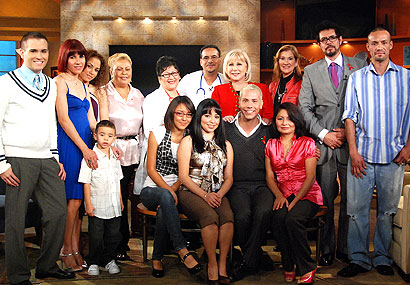“SIDA: 27 Años Despues” (“AIDS: 27 Years Later”) was a special episode of El Show de Cristina (The Cristina Show), which aired on Univision at 10 p.m. Eastern time on Monday, January 5. I attended the taping, so it was a treat to finally see it on air. Here are my thoughts on it, plus and minus.
For background, Cristina Saralegui has been and continues to be a true friend to LGBTs and to people living with HIV/AIDS. In the past 20 years, she has covered related issues countless times on her talk show. Examples include a show in 1992 on sex education where she showed how to correctly use a condom (on a cucumber) and a show in 1996 on same-sex marriage where two gay couples were married.
Protests and controversy followed those episodes, but they only seemed to embolden her. She was the Spanish-language spokesperson for amfAR and then created her own AIDS-related charity, Up With Life/Arriba La Vida Foundation. She was featured in the 1996 premier issue of POZ En Español, the former Spanish-language sister publication of POZ.

“This is not a program of tears, of feeling shame and pity for my guests tonight,” said Cristina during her opening speech. “This is a program of love and, above all, of information and prevention.” Also during her opening speech, Cristina demonstrated her knowledge of HIV/AIDS that didn’t make it on air.
The teleprompter during her opening speech mistakenly read that there were 3 million people worldwide living with HIV. She stopped the taping and redid the take citing the proper statistic of 33 million people worldwide living with HIV. What impressed me the most about that incident was that she not only knew the right stat, but that she was absolutely certain, not needing to have it fact-checked.
The episode overall was a public service to the Spanish-speaking community. Many of the guests were straight, which helped to underscore that HIV is an equal opportunity virus. Some of the guests were from the “Soy” public service campaign developed by the Kaiser Family Foundation and Univision Communications. They included Damaries Cruz and her mother, as well as Luis Salazar.
I do have a few bones to pick. I know that TV viewers need something sweet to go with their medicine. However, I do think that Christian Chávez was too much a part of this show. Yes, he’s a young, cute, openly gay actor and pop singer in Mexico who was in an HIV-related public service campaign. And yes, he is quite well spoken and seems sincere. Nonetheless, the stories of the HIV-positive guests could have been given more time if he hadn’t been on camera so much. (Don’t take it personally Christian, I’d be happy to let you take up some of my off-air time!)
There also was an unfortunate turn into the down low phenomenon. It started with Luis discussing how he had been with men who were married to women. It kept going little by little with almost each female guest after that. It’s true that women need to protect themselves, but the research doesn’t support the myth that Latino and black men who have sex with men are the reason that HIV is increasing among Latinas and black women.
My second-to-last finger wag concerns Jesse Sanchez. Our former POZ cover guy is a young gay man who contracted HIV sexually. As Jesse told his story, it seemed to me that Cristina was placing too much emphasis on making an example out of Jesse instead of getting Jesse to share what he learned as a result of his experience.
My last finger wag concerns Jorge Saavedra. Dr. Saavedra is the head of the Mexican national AIDS program. He disclosed his HIV-positive status years ago, but only recently did he come out as gay. Even though he is an HIV expert with a personal perspective on the virus and the role of homophobia in Latino culture contributing to the spread of the virus, Dr. Saavedra was not given enough time to share his thoughts. Instead, Christian got to share his thoughts, over and over again. To my taste, that wasn’t the right mix.
Despite these critiques, I’m glad that Cristina did this show placing HIV/AIDS front and center in the Spanish-language media. I hope that she continues her advocacy for years to come.
Click here to see a photo slideshow from the episode.
Advertisement
Advertisement
Advertisement







1 Comment
1 Comment